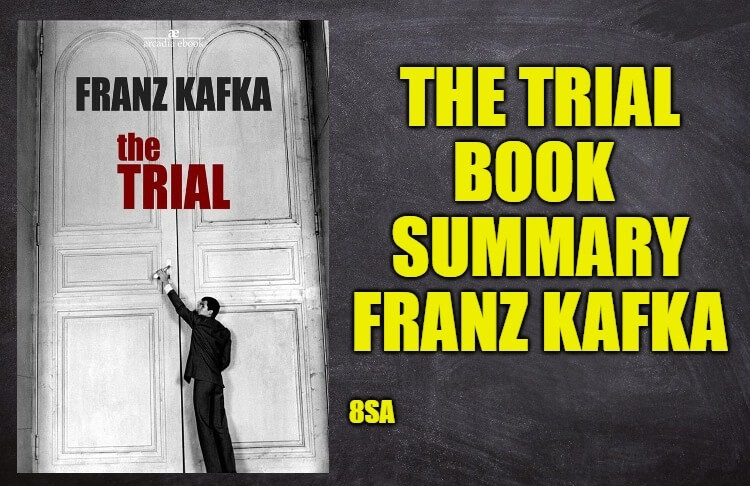What is the summary of the book The Trial written by Franz Kafka? Information about the summary, characters and analysis of The Trial.

The Trial
“The Trial” by Franz Kafka is a novel that explores the theme of the absurdity and meaninglessness of bureaucracy and the justice system. The story follows the main character, Josef K., who is arrested and put on trial for a crime that is never revealed to him. Throughout the book, K. tries to navigate the confusing and surreal legal system while simultaneously questioning his own guilt and innocence.
The novel is often interpreted as a commentary on totalitarianism, as well as an exploration of the human condition and the search for meaning in a seemingly meaningless world. Kafka’s use of symbolism and surrealism adds to the unsettling atmosphere of the book, making it a classic example of the literary genre known as “Kafkaesque.”
Overall, “The Trial” is a powerful and thought-provoking work that continues to resonate with readers today. Its themes and ideas are universal and timeless, and its depiction of the absurdity of bureaucracy and the justice system remains relevant in the modern world.
Book Summary
“The Trial” is a novel by Franz Kafka that was first published posthumously in 1925. It tells the story of a man named Josef K. who is arrested and put on trial for a crime that is never explicitly stated. The novel explores themes of the absurdity of bureaucracy, the meaninglessness of the justice system, and the search for meaning in a seemingly meaningless world.
The story begins with Josef K. waking up one morning to find two men in his bedroom who inform him that he has been arrested. Although K. is initially confused, he soon realizes that the two men are representatives of the court and that he has been accused of a crime. K. is allowed to go about his business and continue working, but he is constantly reminded of his legal predicament by the presence of court officials and lawyers who seem to be everywhere.
As the novel progresses, K. becomes increasingly embroiled in the legal system. He meets with several lawyers who offer him confusing and contradictory advice, and he is forced to attend bizarre court hearings where he is unable to defend himself against vague and undefined charges. K. becomes obsessed with his case, but he is unable to get any answers or make any progress in the legal system.
Throughout the novel, Kafka uses symbolism and surrealism to create a sense of unease and confusion. The court officials and lawyers are often portrayed as bizarre and otherworldly, and the legal proceedings are frequently absurd and nonsensical. K. is portrayed as a man who is struggling to find meaning in a world that seems to be conspiring against him.
As the novel nears its end, K. becomes increasingly desperate and begins to explore alternative methods of escaping his legal predicament. He attempts to bribe court officials and hires a lawyer who promises to help him, but these efforts are ultimately unsuccessful. In the final chapter of the novel, K. is taken to a remote location and executed by two mysterious men who never reveal their identities.
“The Trial” is often interpreted as a commentary on totalitarianism, as well as an exploration of the human condition and the search for meaning in a seemingly meaningless world. The novel’s portrayal of the absurdity of bureaucracy and the justice system continues to resonate with readers today, and its themes and ideas are universal and timeless. Kafka’s use of symbolism and surrealism adds to the unsettling atmosphere of the book, making it a classic example of the literary genre known as “Kafkaesque.”
Characters
- Josef K. – The protagonist of the novel who is arrested and put on trial for a crime that is never revealed to him. He is a successful bank employee who becomes increasingly obsessed with his legal case and the surreal legal system he is forced to navigate.
- Frau Grubach – K.’s landlady who is sympathetic to his plight and tries to help him as much as she can.
- Inspector – The court official who initially informs K. that he has been arrested.
- Leni – A nurse who becomes K.’s mistress and who is also involved in the court system. She offers K. help and advice throughout the novel.
- Advocate Huld – One of the lawyers who is assigned to K.’s case. He offers confusing and contradictory advice to K. and seems to be more concerned with his own reputation than with helping his client.
- The painter – A man who K. meets and who becomes a symbol of the futility of art and creativity in the face of the legal system.
- The priest – A mysterious figure who offers K. spiritual guidance but who ultimately proves to be unhelpful.
- The court officials – A group of bizarre and otherworldly figures who represent the legal system and who seem to be everywhere. They are often depicted as menacing and surreal.
- The two executioners – The men who ultimately carry out K.’s execution at the end of the novel. They are never identified and their motives are never explained.